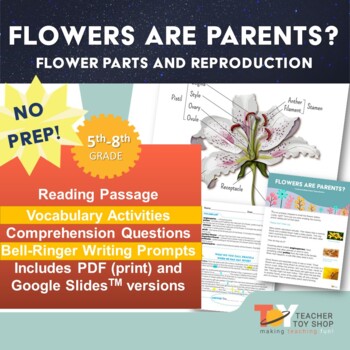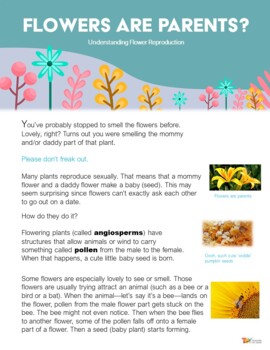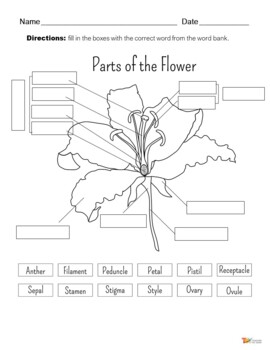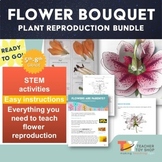Parts of a Flower and Plant Reproduction Activities
- PDF
- Google Apps™
- Easel Activity

Also included in
- Looking for a comprehensive and engaging bundle to teach all about the parts of a flower? Download Parts of a Flower Unit - Worksheets, Activities, Labs, and More! This all-inclusive bundle is designed to equip educators with everything needed to seamlessly teach flowering plant reproduction, makingPrice $17.99Original Price $28.22Save $10.23
- All of Teacher Toy Shop's Life Science resources in one place! Some biology topics included: cells, ecosystems, human body systems and organs, flowers, reproduction, human eye, and more. Includes NGSS aligned lessons, experiments using the Scientific Method, and more.Purchase this bundle for a low-pPrice $49.99Original Price $80.66Save $30.67
Description
Are you looking for an engaging and FUNNY educational resource to help your students understand the parts of a flower and plant reproduction? Download Parts of a Flower and Plant Reproduction Activities! This resource is designed to make learning about flower parts and flowering plant reproduction an enjoyable and informative experience. Dive into the fascinating world of plant life cycles, reproductive parts, and intricate flower diagrams through a blend of print and Google Slides activities.
► Key Teaching Points:
- Specialized Plant Structures: Uncover the impact of specialized plant structures on the success of plant reproduction, fostering a deeper understanding of botanical processes.
- Pollen Transfer Process: Explore the intricate process of transferring pollen and its crucial role in plant reproduction.
- Examples of Plant Structures: Delve into real-world examples, such as bright flowers attracting butterflies for pollen transfer, and the allure of flower nectar and odors that entice insects to aid in pollen transfer.
► What's Included:
- Interactive Reading Comprehension Packet: A 5-page, fully illustrated guide written in a humorous and kid-friendly language, fostering both understanding and enjoyment of botanical concepts.
- Flower Diagram Activity: Engage students in hands-on learning by allowing them to fill in the parts of a flower, reinforcing comprehension through visual representation.
- Kid-Friendly Vocabulary Definitions: Make plant-related terms accessible and relatable with definitions tailored for young learners.
- Self-Checking Vocabulary Worksheet: Turn learning into a game with a worksheet where correct answers reveal clues to a plant-related riddle, adding an element of fun to the educational experience.
- Reading Comprehension Questions: Challenge students with 10 thought-provoking questions at various levels of critical thinking, reinforcing their understanding of plant reproduction.
- Bell-Ringer Writing Prompts: Ignite creativity with 3 engaging writing prompts, encouraging students to express their thoughts and insights.
- Comprehensive Answer Keys: Access all the answers you need for a smooth and efficient teaching experience.
- Google Slides Versions: Seamlessly integrate technology with digital versions of all student worksheets, including a drag-and-drop activity for the Flower Diagram, providing versatility for classroom or remote learning.
- EASEL Activity: Experience the digital version of this resource, complete with audio narration of the reading pages for accessibility and for students who prefer to listen to the information.
Don't miss out on this incredible value-packed resource that not only educates but entertains. Parts of a Flower and Plant Reproduction Activities is your go-to tool for seamlessly integrating humor and learning into the study of flower anatomy and plant reproduction. Elevate your teaching experience and download this comprehensive resource today!
⚠️ BUNDLE & SAVE! ⚠️ Download the complete Parts of a Flower Unit and save on everything you need to teach flower reproduction!
You Might Also Like...
- Parts of a Flower and Plant Reproduction Presentation | PowerPoint SLIDES— A comprehensive slides presentation that goes perfectly with these activities.
- Pop-Up Flower STEM activity— Terrific for reinforcing the parts of the flower!
- Parts of a Flower Dissection Science Lab
✪ Don't forget to follow Teacher Toy Shop to be the first to know about new products, sales and freebies!








